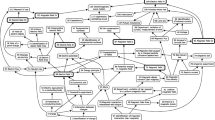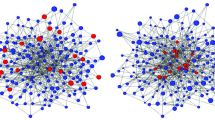Abstract
This study examines differences in conceptual knowledge representations among three groups of students with different levels of study of chemistry. Variation in the structural characteristics of participants’ concept maps on the topic of acid-base equilibrium were sought by indirect means. Year 12 secondary chemistry students, undergraduate chemistry majors and honours, masters and doctoral candidates participated in the study. Paired propositional links in the concept maps for the three groups were analysed by the scaling algorithms “Pathfinder” and multidimensional scaling. Results show differences among groups in the structural significance in the networks of abstract process-related nodes and matter-related nodes. Implications for theories of conceptual change are discussed.
Similar content being viewed by others
References
Acton, W. H., Johnson, P. J., & Goldsmith, T. E. (1994). Structural knowledge assessment: Comparison of referent structures.Journal of Educational Psychology, 86, 303–311.
Board of Senior Secondary School Studies. (1987).Senior, chemistry syllabus. Brisbane: Author.
Cañas, J. J., Bajo, M.-T., & Gonzalvo, P. (1994). Mental models and computer programming.International Journal of Human-Computer Studies, 40, 795–811.
Champagne, A. B., Gunstone, R. F., & Klopfer, L. E. (1985). Effecting changes in cognitive structures among physics students In L. H. T. West & A. L. Pines (Eds.),Cognitive Structure and Conceptual Change, (pp. 163–187)., New York: Academic Press.
Chi, M. T. H., Glaser, R., & Farr, M. J. (1988).The nature of expertise. Hillsdale: Lawrence Erlbaum.
Chi, M. T. H., Slotta, J. D., & de Leeuw, N. (1994). From things to processes: A theory of conceptual change for learning science concepts.Learning and Instruction, 4, 27–43.
Cooke, N. J. (1992). Eliciting semantic relations for empirically derived networks.International Journal of Man and Machine Studies, 37, 721–750.
Duit, R. (submitted). Conceptual change-change of ontological categories only.Learning and Instruction.
Durso, F. T., & Coggins, K. A. (1990). Graphs in the social and psychological sciences: Empirical contributions of Pathfinder. In R. W. Schvaneveldt (Ed.), Pathfinder associative networks: Studies in knowledge organization., (pp. 31–51). Norwood: Ablex Publishing Corporation.
Ericsson, K. A., & Smith, J. (Eds.) (1991).Toward a general theory of expertise. Cambridge: Cambridge University Press.
Gabel, D. (1994).Handbook of research on science teaching and learning. New York: Macmillan Publishing.
Gillan, D. J., Breedin, S. D., & Cooke, N. J. (1992). Network and multidimensional representations of the declarative knowledge of human-computer interface design experts.International Journal of Man and Machine Studies, 36, 587–615.
Goldsmith, T. E., Johnson, P. J., & Acton, W. H. (1991). Assessing structural knowledge.Journal of Educational Psychology, 83, 88–96.
Gonzalvo, P., Cañas, J. J., & Bajo, M.-T. (1994). Structural representations in knowledge acquisition.Journal of Educational Psychology, 86, 601–616.
Gorodetsky, M., & Hoz, R. (1985). Changes in the group cognitive structure of some chemical equilibrium concepts following a university course in general chemistry.Science Education, 69, 185–199.
Gussarsky, E., & Gorodetsky, M. (1988). On the chemical equilibrium concept: Constrained word associations and conception.Journal of Research in Science Education, 25, 319–333.
Gussarsky, E., & Gorodetsky, M. (1990). On the concept “chemical equilibrium”: The associative framework.Journal of Research in Science Teaching, 27, 197–204.
Interlink Inc. (1992).KNOT-Mac: Knowledge network organizing tool for the Mac (software). Las Cruces: Author.
Jonassen, D. H., Beissner, K., & Yacci, M. (1993).Structural knowledge: Techniques for representing, conveying, and acquiring structural knowledge. Hillsdale, NJ: Lawrence Erlbaum Associates.
Markham, K. M., Mintzes, J. J., & Jones, M. G. (1994). The concept map as a research and evaluation tool: Further evidence of validity.Journal of Research in Science Teaching, 31, 91–101.
Maskill, R., & Cachapuz, A. F. C. (1989). Learning about the chemistry topic of equilibrium: The use of word association tests to detect developing conceptualizations.International Journal of Science Education, 11, 57–69.
Nakleh, M., & Krajcik, J. S. (1993). A protocol analysis of the influence of technology on students’ actions, verbal commentary, and thought processes during the performance of acidbase titrations.Journal of Research in Science Teaching, 30 1149–1168.
Nakleh, M., & Krjacik, J. S. (1994). Influence of levels of information as presented by different technologies on students’ understanding of acid, base and pH concepts.Journal of Research in Science Teaching, 31, 1077–1096.
Naveh-Benjamin, M., McKeachie, W. J., Lin, Y., & Tucker, D. G. (1986). Infering students’ cognitive structure and their development using the “ordered tree technique”.Journal of Educational Psychology, 78, 130–140.
Norusis, M. J., & SPSS. (1994). SPSS professional statisticsTM6.1. Chicago: SPSS Inc.
Novak, J. D., & Gowin, D. (1984).Learning how to learn. New York: Cambridge University Press.
Novak, J. D., & Musonda, D. (1991). A twelve-year longitudinal study of science concept learning.American Educational Research Journal, 28, 117–153.
Olson, J. R., & Biolsi, K. J. (1991). Techniques for representing expert knowledge. In K. A. Ericsson & J. Smith (Eds.),Toward a general theory of expertise (pp. 240–285). Cambridge: Cambridge University Press.
Pfundt, H., & Duit, R. (1994).Bibliography: Students’ alternative frameworks and science education. Kiel, Germany: Institute for Science Education.
Ross, B., & Munby, H. (1991). Concept mapping and misconceptions: A study of high school students’ understandings of acids and bases.International Journal of Science Education, 13, 11–23.
Roth, W.-M., Gabel, D., Brown, L., & Rice, D. (1992). A combined method of INDSCAL and cognitive mapping for describing changes in students’ cognitive structure.Journal of Educational and Psychological Measurement, 52, 769–779.
Ruiz-Primo, M. A., & Shavelson, R. J. (1996). Problems and issues in the use of concept maps in science assessment.Journal of Research in Science Teaching, 33, 569–600.
Rye, J. A., & Rubba, P. A. (1998). An exploration of the concept map as an interview tool to facilitate the externalization of students’ understanding about global atmospheric change.Journal of Research in Science Teaching, 35, 521–546.
Saitta, L., Neri, F., Bajo, M. T., Cañas, J., Chaiklin, S., Esposito, F., Kayser, D., Nédellec, C., Sabah, G., Tiberghien, A., Vergnaud, G., & Vosniadou, S. (1995). Knowledge representation changes in humans and machines. In P. Reimann, & H. Spada (Eds.),Learning in humans and machines: Towards and interdisciplinary learning science (pp. 109–127). New York: Pergamon.
Schoenfeld, A., & Herrmann, D. (1982). Problem perception and knowledge structures in expert and novice mathematical problem solvers.Journal of Experimental Psychology: Learning, Memory and Cognition, 8, 484–494.
Schmidt, H.-J. (1991). A label as a hidden persuader: Chemists’ neutralization concept. International.Journal of Science Education, 13, 459–471.
Schmidt, H.-J. (1995). Applying the concept of conjugation to the Brønsted theory of acid-base reactions by senior high school students from Germany.International Journal of Science Education, 17, 733–741.
Schvaneveldt, R. W. (Ed.) (1990).Pathfinder associative networks: Studies in knowledge organization. Norwood: Ablex Publishing Corporation.
Schvaneveldt, R. W., Dearholt, D. W., & Durso, F. T. (1988). Graph theoretic foundations of Pathfinder networks.Computers and Mathematics with Applications, 15, 337–345.
Schvaneveldt, R. W., Durso, F. T., & Dearholt, D. W. (1989). Nework structures in proximity data. In G. Bower (Ed.),The psychology of learning and motivation: Advances in research and theory (Vol. 24, pp. 249–284). New York: Academic Press.
Schvaneveldt, R. W., Durso, F. T., Goldsmith, T. E., Bree, T. B., Cooke, N. M., De Maio, J. C. (1985). Measuring the structure of expertice.International Journal of Man-Machine Studies, 23, 699–728.
Shavelson, R. (1972). Some aspects of the correspondence between content structure and cognitive structure in physics instruction.Journal of Educational Psychology, 63, 225–234.
Slotta, J. D., Chi, M. T. H., & Joram, E. (1995). Assessing students’ misclassification of physics concepts: An ontological basis for conceptual change.Cognition and Instruction, 13, 373–400.
Thagard, P. (1996).Mind: Introduction to cognitive science. Cambridge, MA: The MIT Press.
Vosniadou, S. (1995). A cognitive psychological approach to learning. In P. Reimann, & H. Spada (Eds.),Learning in humans and machines: Towards an interdisciplinary learning science, (pp. 23–35). New York: Pergamon.
Wallace, J. D., & Mintzes, J. J. (1990). The concept map as a research tool: Exploring conceptual change in biology.Journal of Research in Science Teaching, 27, 1033–1052.
Wilson, J. M. (1994). Network representations of knowledge about chemical equilibrium: Variations with achievement.Journal of Research in Science Teaching, 31 1133–1147.
Wilson, J. M. (1996). Concept maps about chemical equilibrium and students’ achievement scores.Research in Science Education, 26, 169–185.
Author information
Authors and Affiliations
Corresponding author
Rights and permissions
About this article
Cite this article
Wilson, J.M. Differences in knowledge networks about acids and bases of year-12, undergraduate and postgraduate chemistry students. Research in Science Education 28, 429–446 (1998). https://doi.org/10.1007/BF02461508
Issue Date:
DOI: https://doi.org/10.1007/BF02461508




